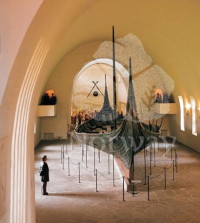
Photo. The Gokstad Ship. The Viking ship at Bygdøy in
Oslo
(Norway ) - Viking ship museum
culture architecture, photo number 122000-99#236, photographer Johan Berge/NTR (www.invanor.no).
The Gokstad
Ship, is one of three ships displayed in Oslo's
Viking
Ships Museum, was also
found in Vestfold
County.
According to the
Norwegian national Newspaper Aftenposten, 21 October 2003
(www.Aftenposten.no), researchers
from the University of
Oslo
used radar to examine the Viking burial site.
Photos have
revealed an oval shape lying about a meter under the pile of stones atop the
mound, called a gravroeysa in Norwegian (Rom vestre i Slagen) This is also
confirmed by the major of Vestfold
County,
Egil Holm (source: Vestfold Fylkeskommune, 15.10.03, website: www.vfk.no).
Researchers also
think the ship may be intact. Clay in the area preserved the Gokstad ship for
more than a thousand years, so it's believed that conditions have allowed the
preservation of another ship as well. But according to the Egil Holm there are
signs on the 15 - 20 metres ship that it might be
plundered.
The
Vestfold
County and
Toensberg are really a historical area. It can be mentioned that the Toensberg
(Tønsberg) and Nøtterøy Library was founded in 1909. It is run as a mutual
library for the boroughs of Tønsberg and Nøtterøy. In 1992 the library moved to
a modern building in Tønsberg city centre, at 16, Storgata. It was built on the
site of St Olav's Monastery. The monastery ruins and the remains of two Viking
ship graves provide an exiting contrast to the modern technology and
architecture of the building.
The Gokstad
Ship, now one of the "crown jewels" in
Oslo's
Viking
Ships Museum on the
Bygdoey peninsula, was found just a kilometer-and-a-half away from the current
found. It's believed to have been built around 890 and likely belonged to a king
or chieftain. The found is under excavation by the archaeologist Trude Aga Brun
of Vestfold County and her colleagues.
Many Viking ship graves
have been found in Norway over the years, but most
of the vessels had rotted away and graves also had been plundered in earlier
centuries. But we have to hope the best, and we look forward to see the "intact"
result!
Stein Morten Lund, 5 November 2003
Additional
information
Report in Norwegian about the discovery -
Vestfold Fylkeskommune`s website: www.vfk.no.
Some Viking
ship Museums:
The
Viking
Ship
Museum
(Oslo,
Norway):
One of the most
famous Viking ships, the Gokstad ship, was found in a large burial mound at the
Gokstad farm in Sandar, Vestfold in 1880
(Norway
). The ship had been
built around 890 A.D. and later used in the ship burial of an important chieftain who
died in or around 900 A.D.
The dead man, a
powerfully built man in his 60`s, lay in his bed in a timber burial chamber
(displayed in the Tune wing of the Museum).
He was
buried with his grave furnishings which consisted of three small boats, a tent, a
sledge and riding equipment.
The preservation
conditions in the Gokstad mound were as favourable as at Oseberg. The mound had
been plundered in ancient times, however, and any valuables of silver and gold
which may have been deposited as burial goods, were removed.
For more
information click on the link: www.norway.com.
Address:
Huk Aveny 35,
N-0287 Oslo
P.O. Box 6762
St. Olavs plass, N-0130 Oslo
Phone: +47 2213
5280
Fax: +47 2244
5581
E-mail: info@ukm.uio.no
Website: www.ukm.uio.no
Lofotr - the
Viking
Museum at
Borg:
www.lofotr.no
Prestegårdsveien 59
8360 Bøstad
Norway
Tel.: + 47 76 08 49 00
Fax: + 47 76 08 49 10
The
Viking
Ship
Museum in
Denmark:
Vindeboer 12, DK-4000 Roskilde,
Denmark
Phone: +45 4630 0200
This museum
houses five authentic Viking ships, all about 1,000 years old that were
excavated from the Roskilde Fjord in 1962. There is also a film that tells how
the ships were brought up from the bottom of the Fjord. Historians believe that
the ships were purposely sunk to create a barrier from rival raiding Vikings.
The
Viking
Museum in
England:
Read more about the discovery and displaying on
the Yorkshire Museum & Gardens:www.yorkshiremuseum.org.uk.
The
Yorkshire
Museum is built
on the ancient site of Earlsburgh, believed to have been a base for Viking earls
outside the city walls of Jorvik. Earl Siward, one of the rulers of
Anglo-Scandinavian York, is buried in the nearby St Olave's Church (founded by
Siward in memory of the Norweigan King, Saint Olaf) and it is likely his home
was on the Museum
Gardens
site.
Address:
Yorkshire
Museum &
Gardens, York,
England.
It`s located
next to Lendal Bridge, the main crossing between the York Station and York
Minster. The entrances are on Museum Street and
Marygate.
